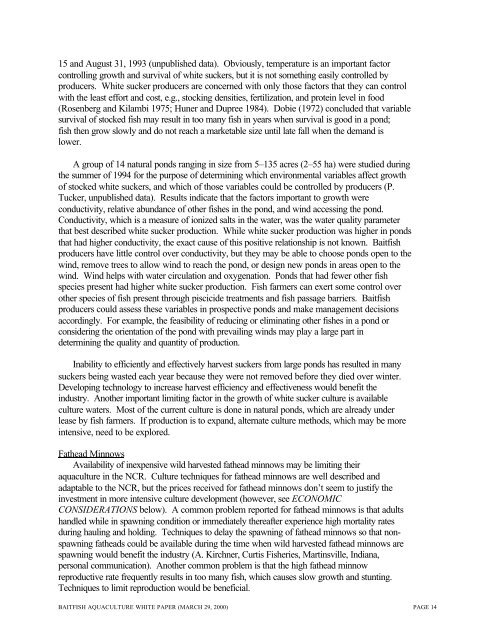a white paper on the status and needs of baitfish ... - NCRAC
a white paper on the status and needs of baitfish ... - NCRAC
a white paper on the status and needs of baitfish ... - NCRAC
You also want an ePaper? Increase the reach of your titles
YUMPU automatically turns print PDFs into web optimized ePapers that Google loves.
15 <strong>and</strong> August 31, 1993 (unpublished data). Obviously, temperature is an important factor<br />
c<strong>on</strong>trolling growth <strong>and</strong> survival <strong>of</strong> <str<strong>on</strong>g>white</str<strong>on</strong>g> suckers, but it is not something easily c<strong>on</strong>trolled by<br />
producers. White sucker producers are c<strong>on</strong>cerned with <strong>on</strong>ly those factors that <strong>the</strong>y can c<strong>on</strong>trol<br />
with <strong>the</strong> least effort <strong>and</strong> cost, e.g., stocking densities, fertilizati<strong>on</strong>, <strong>and</strong> protein level in food<br />
(Rosenberg <strong>and</strong> Kilambi 1975; Huner <strong>and</strong> Dupree 1984). Dobie (1972) c<strong>on</strong>cluded that variable<br />
survival <strong>of</strong> stocked fish may result in too many fish in years when survival is good in a p<strong>on</strong>d;<br />
fish <strong>the</strong>n grow slowly <strong>and</strong> do not reach a marketable size until late fall when <strong>the</strong> dem<strong>and</strong> is<br />
lower.<br />
A group <strong>of</strong> 14 natural p<strong>on</strong>ds ranging in size from 5–135 acres (2–55 ha) were studied during<br />
<strong>the</strong> summer <strong>of</strong> 1994 for <strong>the</strong> purpose <strong>of</strong> determining which envir<strong>on</strong>mental variables affect growth<br />
<strong>of</strong> stocked <str<strong>on</strong>g>white</str<strong>on</strong>g> suckers, <strong>and</strong> which <strong>of</strong> those variables could be c<strong>on</strong>trolled by producers (P.<br />
Tucker, unpublished data). Results indicate that <strong>the</strong> factors important to growth were<br />
c<strong>on</strong>ductivity, relative abundance <strong>of</strong> o<strong>the</strong>r fishes in <strong>the</strong> p<strong>on</strong>d, <strong>and</strong> wind accessing <strong>the</strong> p<strong>on</strong>d.<br />
C<strong>on</strong>ductivity, which is a measure <strong>of</strong> i<strong>on</strong>ized salts in <strong>the</strong> water, was <strong>the</strong> water quality parameter<br />
that best described <str<strong>on</strong>g>white</str<strong>on</strong>g> sucker producti<strong>on</strong>. While <str<strong>on</strong>g>white</str<strong>on</strong>g> sucker producti<strong>on</strong> was higher in p<strong>on</strong>ds<br />
that had higher c<strong>on</strong>ductivity, <strong>the</strong> exact cause <strong>of</strong> this positive relati<strong>on</strong>ship is not known. Baitfish<br />
producers have little c<strong>on</strong>trol over c<strong>on</strong>ductivity, but <strong>the</strong>y may be able to choose p<strong>on</strong>ds open to <strong>the</strong><br />
wind, remove trees to allow wind to reach <strong>the</strong> p<strong>on</strong>d, or design new p<strong>on</strong>ds in areas open to <strong>the</strong><br />
wind. Wind helps with water circulati<strong>on</strong> <strong>and</strong> oxygenati<strong>on</strong>. P<strong>on</strong>ds that had fewer o<strong>the</strong>r fish<br />
species present had higher <str<strong>on</strong>g>white</str<strong>on</strong>g> sucker producti<strong>on</strong>. Fish farmers can exert some c<strong>on</strong>trol over<br />
o<strong>the</strong>r species <strong>of</strong> fish present through piscicide treatments <strong>and</strong> fish passage barriers. Baitfish<br />
producers could assess <strong>the</strong>se variables in prospective p<strong>on</strong>ds <strong>and</strong> make management decisi<strong>on</strong>s<br />
accordingly. For example, <strong>the</strong> feasibility <strong>of</strong> reducing or eliminating o<strong>the</strong>r fishes in a p<strong>on</strong>d or<br />
c<strong>on</strong>sidering <strong>the</strong> orientati<strong>on</strong> <strong>of</strong> <strong>the</strong> p<strong>on</strong>d with prevailing winds may play a large part in<br />
determining <strong>the</strong> quality <strong>and</strong> quantity <strong>of</strong> producti<strong>on</strong>.<br />
Inability to efficiently <strong>and</strong> effectively harvest suckers from large p<strong>on</strong>ds has resulted in many<br />
suckers being wasted each year because <strong>the</strong>y were not removed before <strong>the</strong>y died over winter.<br />
Developing technology to increase harvest efficiency <strong>and</strong> effectiveness would benefit <strong>the</strong><br />
industry. Ano<strong>the</strong>r important limiting factor in <strong>the</strong> growth <strong>of</strong> <str<strong>on</strong>g>white</str<strong>on</strong>g> sucker culture is available<br />
culture waters. Most <strong>of</strong> <strong>the</strong> current culture is d<strong>on</strong>e in natural p<strong>on</strong>ds, which are already under<br />
lease by fish farmers. If producti<strong>on</strong> is to exp<strong>and</strong>, alternate culture methods, which may be more<br />
intensive, need to be explored.<br />
Fa<strong>the</strong>ad Minnows<br />
Availability <strong>of</strong> inexpensive wild harvested fa<strong>the</strong>ad minnows may be limiting <strong>the</strong>ir<br />
aquaculture in <strong>the</strong> NCR. Culture techniques for fa<strong>the</strong>ad minnows are well described <strong>and</strong><br />
adaptable to <strong>the</strong> NCR, but <strong>the</strong> prices received for fa<strong>the</strong>ad minnows d<strong>on</strong>’t seem to justify <strong>the</strong><br />
investment in more intensive culture development (however, see ECONOMIC<br />
CONSIDERATIONS below). A comm<strong>on</strong> problem reported for fa<strong>the</strong>ad minnows is that adults<br />
h<strong>and</strong>led while in spawning c<strong>on</strong>diti<strong>on</strong> or immediately <strong>the</strong>reafter experience high mortality rates<br />
during hauling <strong>and</strong> holding. Techniques to delay <strong>the</strong> spawning <strong>of</strong> fa<strong>the</strong>ad minnows so that n<strong>on</strong>spawning<br />
fa<strong>the</strong>ads could be available during <strong>the</strong> time when wild harvested fa<strong>the</strong>ad minnows are<br />
spawning would benefit <strong>the</strong> industry (A. Kirchner, Curtis Fisheries, Martinsville, Indiana,<br />
pers<strong>on</strong>al communicati<strong>on</strong>). Ano<strong>the</strong>r comm<strong>on</strong> problem is that <strong>the</strong> high fa<strong>the</strong>ad minnow<br />
reproductive rate frequently results in too many fish, which causes slow growth <strong>and</strong> stunting.<br />
Techniques to limit reproducti<strong>on</strong> would be beneficial.<br />
BAITFISH AQUACULTURE WHITE PAPER (MARCH 29, 2000) PAGE 14


